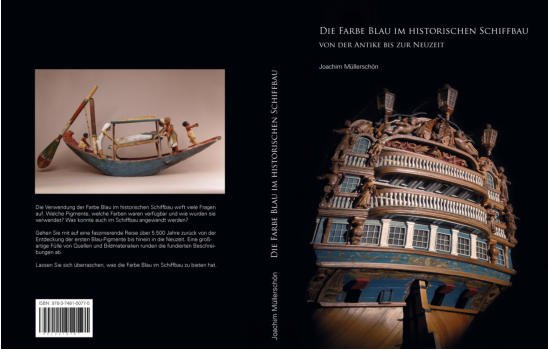-
Posts
13,302 -
Joined
-
Last visited
Content Type
Profiles
Forums
Gallery
Events
Everything posted by druxey
-
Unfortunately talk of mutiny makes me think of the film Battleship Potemkin by Eisenstein.
-
I'd like to pick up on an earlier point about color (post #1687). Specifically, the comment about Turner's paintings. As we know, Turner was obsessed with the effects of light and atmosphere. Now, what he was recording was a perception of color. Objects have a specific color, called local color by artists. Depending on the quality of light falling on an object its apparent color as we perceive it changes. For instance, think of a 'red' ball. Its surface properties will reflect the red wavelengths of the visible light spectrum and absorb the others. So, the ball appears red under white light or red light. Both varieties of light contain the red part of the spectrum. However, shine green light on it and it will appear dark brown. Very little light is reflected as the red portion of the spectrum is missing in green light. So, Turner was playing with color as it is perceived under different lighting conditions. He was not concerned with ship modelers 200 years later! Which color in his paintings is 'correct', then? Neither and both!
-
There may be traces of RTV deposit or talc on the surface of the casting, Mark. I cleaned the surfaces of my castings with isopropanol, then a 400 grit 3M/Scotch-Brite abrasive 'spider' wheel (radial bristle disc) run at slow speed in my rotary tool. I can't speak for the shelf life of Jax chemicals. Perhaps the manufacturer has specs on that.
-

HMCSS Victoria 1855 by BANYAN - 1:72
druxey replied to BANYAN's topic in - Build logs for subjects built 1851 - 1900
Very nicely done, Pat.- 1,005 replies
-
- gun dispatch vessel
- victoria
-
(and 2 more)
Tagged with:
-
Pretty ambitious and accomplished for 17, I'd say, Steven!
- 740 replies
-
- Tudor
- restoration
-
(and 4 more)
Tagged with:
-
That's the trick to lining out, Maury: first divide the space to be planked mathematically, then adjust things until they look good to the eye from all angles. First the science, then the art!
-

Should I build Benjamin Latham?
druxey replied to Dr PS - Paul Schulze's topic in Wood ship model kits
Judging from the model you've successfully completed, you already have two necessary skills; 'stick-to-it-iveness' and carefulness. Another more ambitious model will not only exercise those skills but develop new ones. I'd say, go for it! There are many folk who can help clarify any questions you might have, so there is a good support resource right here on MSW. The only criterion is that you have an affection for the subject of your build. -
Interesting 'mod' to your saw, Kurt! I like it.
-
I'd like to draw your attention to a new book on the history for the use of blue on ships. This book, now in English, by Joachim Mullerschon is available through: http://www.modellbau-muellerschoen.de/buch-en.htm Titled The colour blue in historic shipbuilding, originally Die Farbe Blau im historischen Schiffbau - von der Antike bis zur Neuzeit, This book, lavishly illustrated in color, traces the use of different blue pigments from antiquity to the present as used on ships. Chemistry, social history and geography are just some of the topics covered by this monograph. I will leave it for someone else to review critically in detail, as - full disclosure - I was the English language editor of this volume.
-
Looks good. Will you put a long handle on the mini-drill? My first 'serious' model was a 64 gun ship, fully planked at 1:48 scale. All the treenail holes were drilled by hand using a pin vise. I'd never do that again!
- 306 replies
-
- schooner
- la jacinthe
-
(and 1 more)
Tagged with:
-
Chris: stupid question, perhaps, but I'll ask anyway. Is the blade mounted in the reverse direction? How do I know to ask this question? Don't ask!
-
I'm sorry for the loss of your friend, Rob. Your model continues to impress me, especially at that scale.
- 1,208 replies
-
- great republic
- clipper
-
(and 1 more)
Tagged with:
About us
Modelshipworld - Advancing Ship Modeling through Research
SSL Secured
Your security is important for us so this Website is SSL-Secured
NRG Mailing Address
Nautical Research Guild
237 South Lincoln Street
Westmont IL, 60559-1917
Model Ship World ® and the MSW logo are Registered Trademarks, and belong to the Nautical Research Guild (United States Patent and Trademark Office: No. 6,929,264 & No. 6,929,274, registered Dec. 20, 2022)
Helpful Links
About the NRG
If you enjoy building ship models that are historically accurate as well as beautiful, then The Nautical Research Guild (NRG) is just right for you.
The Guild is a non-profit educational organization whose mission is to “Advance Ship Modeling Through Research”. We provide support to our members in their efforts to raise the quality of their model ships.
The Nautical Research Guild has published our world-renowned quarterly magazine, The Nautical Research Journal, since 1955. The pages of the Journal are full of articles by accomplished ship modelers who show you how they create those exquisite details on their models, and by maritime historians who show you the correct details to build. The Journal is available in both print and digital editions. Go to the NRG web site (www.thenrg.org) to download a complimentary digital copy of the Journal. The NRG also publishes plan sets, books and compilations of back issues of the Journal and the former Ships in Scale and Model Ship Builder magazines.



